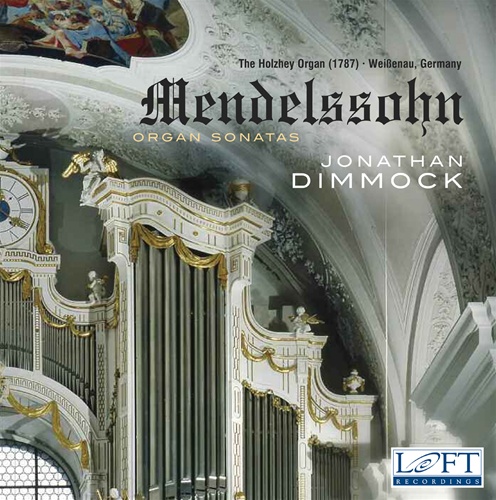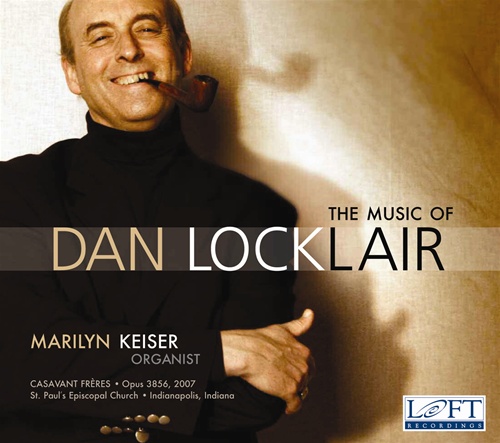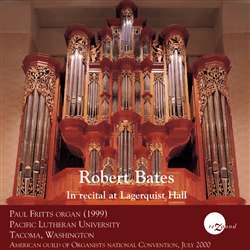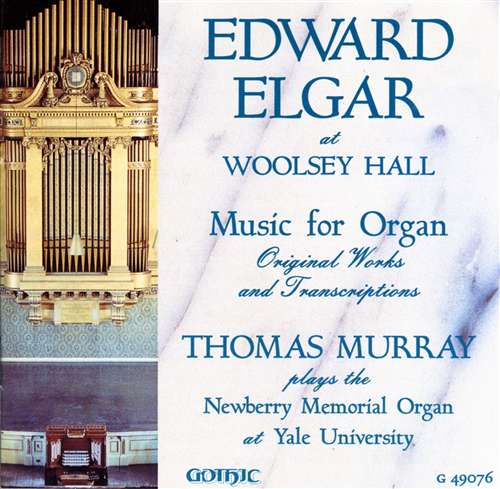Yesterday we introduced you to the Robert Bates album "
Viaticum" which consists of his original compositions. So today we thought we would share some reviews of this album as well as an interview with Robert Bates!
Here is a remarkable concert of organ music of the 20th century, in which not a single work suffers from the faults that generally weigh on contemporary music… This selection lets us hear the best of what is being written for organ in recent years. And I include the pieces by Bates himself, whether for solo organ or organ accompanied by synthesizer or pre-recorded organ; it is music that can be listened to again and again with real pleasure verging on the spellbinding.
Bates as a player also deserves plenty of compliments: he plays clearly, precisely, and not without emotion…”
- “Magazine Orgue” (Belgium)
“Viaticum is a recording for organ and narrator, featuring 20th century organ works by Arvo Pärt, Jean Guillou, György Ligeti, Joan Tower, Calvin Hampton, and original works by Robert Bates. The 3-CD set is organized into three programs, describing the life and death journeys of the body, mind and soul. Recorded with 24-bit technology at Stanford Memorial Church, Viaticum utilizes the two organs in the rear gallery (Fisk, 1984 and Murray Harris, 1901), in ensemble with electronic instruments on some pieces. This unusual recording is a sonic spectacular, and presents the organ as it is rarely heard, with an unusual repertoire. Many pieces are recorded here for the first time. For additional information, read the Fanfare reviews (below).”
"Bates is obviously a highly accomplished performer, as one would expect from an organist in such demand. The clarity of his articulation is immaculate, and his choice of the two fine organs at the Stanford Memorial Church was inspired, as both record beautifully."
-BY DAVID DENTON
Fanfare Magazine
A View from the Organ Loft: An Interview with Robert Bates
BY DAVID DENTON Fanfare Magazine
"Travel with me and I will supply the Viaticum, the provisions for your journey." This is the opening line of a new trilogy of words and music, Viaticum, by organist and composer Robert Bates, newly recorded and just released on the Loft Recordings label. Extending to almost three hours, the work takes the listener on three separate pilgrimages, each exploring the nature of the universe through the thoughts of philosophers, scientists, and clerics. With so much research having been necessary to collate the intricate details involved in the text, I asked Bates how long he had been involved in creating the work. "Most of it results from reading over the years, and particularly my interest in books on philosophy and modern science. The problem came the other way around, and I had to whittle my original wording down to a length that would balance with the musical content. The work originated with the contents of the third disc, Life after Life, and it was the favorable response to that section in a concert performance that prompted me to extend it to three parts." At that juncture the work had no name, Viaticum, the Latin word for "provisions for a journey," seeming very appropriate once the score had been completed. That third part deals with religion and the traditional journey to everlasting life for those fortunate enough to achieve celestial bliss. Is this the concept of death that Bates believes in? "I have to say that I am not a religious person in the strict sense of the word. I am a person who relates more to philosophy, and the answer to your question is: I don't really know."
Bates was educated at Wayne State University and Southern Methodist University, before moving to France to continue his organ studies with Marie-Claire Alain and improvisation with Daniel Roth. His return to the States took him to Stanford University, where he graduated in musicology, with the emphasis on performing practices and history of music theory. Today he is associate professor of organ and university organist at the Moores School of Music at the University of Houston. "When I left northern California exactly one year ago to come to Houston, I discovered that housing was one-third to one-half the price here as it was there! I was able to buy a wonderful and unusual house in an old Victorian-era section of Houston called the Heights. The name comes from the fact that the area is 20 feet higher than the rest of Houston, so it doesn't flood as often during our famous storms. What we have is a brand-new home made to look like an 1880s firehouse. People come in and say things like, "This is the best restoration I've ever seen"; you should see their faces when I tell them it is 100% new! Best part is that the ceilings are high enough for my very tall Mason and Hamlin reed organ, built around the same time as most of the neighborhood. Houston is a marvelous place for the performing arts, which are very much alive here. People take pride in the arts and are amazingly knowledgeable about them, and those with money give support through museums, opera, education, etc."
During his student days Bates garnered an enviable collection of competition successes, including the Los Angeles prize in 1976, his return there 17 years later as a judge being a particularly happy memory. As a concert organist he was soon in demand around North America and Europe, and it was for a 1998 concert at the Redlands Organ Festival in Southern California that Life after Life had its world premiere. The program was successfully repeated at many venues, and the idea for a much more extensive work took shape. I asked, "Was that inspiration started by the words or the music?" "The whole thing rather evolved, previous music that I had composed suggested the text, and at other times I composed music specifically as a response to an idea from the words. There became an interaction between the two, and at first I just intended adding one further section, and that grew to the idea of three journeys. I hope that the whole will be a journey that will help people to understand more about life."
Though Bates has used the words and thoughts of great philosophers and scientists, in selecting those words there is inevitably a personal input of the ideas and ideals that appear important to Bates. I wanted to return to the third part of Viaticum, which, as a person still searching for a religion, I found the most difficult to accept. "Even if religion were only an invention of humanity," urges Bates, "you can still learn a lot from it without actually believing in it. We can read about mythology and not believe one word of it, but it can still speak to us and help us understand ourselves." I accept his theory, though, on a lighter note, I am not quite sure how that willingness to expose his thought process squares up to his response to "pop" music. "People say that I would like it if I just knew more about it and listened more. But I doubt it. One simply can't avoid lots of exposure to pop music at this time in our history. Jazz I enjoy, but I know little about it. I don't think that it has had much influence on my own music. People from outside the US often assume Americans know all about jazz, but more often than not we don't. I do love some folk music when I hear it-Balinese, Indian, Thai, for example-but I'm certainly no ethnomusicologist. On the other hand, there are obvious influences from the music of other cultures to be found in my own music, mostly via Western composers such as Olivier Messiaen and Jehan Alain, and partly through my personal preferences for scales that have an "exotic" sound. And now that I think of it, I guess I tend to play pieces by other composers that are a bit exotic sounding." His choice of music by other composers for Viaticum certainly shows a very wide taste, with Arvo Pärt, Jean Guillou, György Ligeti, Joan Tower, and Calvin Hampton among the eight composers represented. In total they supply the bulk of the music, though the eight works by Bates are the largest single contribution. Many of his scores include parts for synthesizer and prerecorded organ. "Organists can be rather conservative, and we need a little more invention to our approach. I became involved in computers at Stanford University when I seemed to be surrounded by computer engineers. There is quite a big department at Stanford in the field of electronic music, and that technology is now with us, and ours to use. If we can harness it and use it to good taste in music that we believe in, we can expand the traditions of music. If we don't, others will, and that use may not be to the benefit of classical music. I have used synthesizers with organ, prerecorded tape to layer on top of the organ texture, and generally experimented with the sonorities that are possible. I don't know of other organists who are working in this field, though I am sure there must be a parallel elsewhere. I admit I am not a fan of electronic organs, but what will happen to organs in the future we don't know, so you have to keep an open mind."
In Viaticum Bates also examines the use of visual aids to communicate with the audience. This is not a visual presentation of notes, but a picture, similar to a graph, plotting the movement of the music, and, whether you are a musician or not, you can follow the progress of the work. "The spoken text will create a visual image of the music in the listener's mind. That was one objective. Then they can follow the images drawn out. I find people who know about music are intrigued at the idea, and nonmusicians are surprised that they can follow the music in this manner. It is something that I will now take further." Packaged with the three discs come these graphic "scores" for three of the works, Orpheus and the Winged Creatures, Charon's Oar, and Hades' Realm. "I would say that in the United States the organ itself is not very fashionable, so that any aid to draw people into the performance is a plus. We live in a visual era, where images constantly flash before us, and I find that a lot of people simply do not like sitting and simply listening to music, yet they do enjoy a visual stimulus."
Listening to the works by Bates you would hardly guess the name of his favorite composer. "I like many early composers, such as the great Dietrich Buxtehude, who was such an influence on Bach; the early Spanish composers-Correa de Arauxo is my favorite; early French composers such as François Couperin, and a number of living composers, especially Arvo Pärt. The greatest composer of organ music in the 20th century is clearly Olivier Messiaen, so I play much of his music. Some performers will happily play anything that comes along. I can't afford the time to play everything. But Bach is so far in the lead that it hardly makes sense to mention others. My own music-well, I know it does not sound much like Bach-has taken one major thing from him. You can listen to Bach on many levels. You can just sit and enjoy one of his big organ Toccata and Fugues without knowing anything about the music, or you can investigate every strand as a musicologist. I am not saying my music is in that caliber, but I like to work in several layers, so that it can hold your attention and you can discover more on repeated hearing. I also try to capture that inner logic in Bach's writing. So to that extent there is a similarity."
For Viaticum Bates has used the two organs at the Stanford Memorial Church, and, in common with every organist, he has his favorite instruments. "I do love those two, but I just played for the national convention of the American Guild of Organists on a beautiful new organ built by Paul Fritts at the Pacific Lutheran University in Tacoma, Washington. Historic French and German organs always interest me, and those in Mexico from the 17th century have become a new area of fascination. I sometimes get the feeling during a concert that I'm playing my absolute all-time favorite; the feeling may only last for the duration of the recital, but that is enough. The question is a bit like another I have often been asked: "What is your favorite Bach work?" The answer, of course, is "The one I am playing at the moment." But, on the other hand, it is difficult to feel inspired by a bad organ-and there are far too many of those in this world. In the States we have some marvelous organs being built. I don't think the quality has ever been better, and the level of playing is now very high. But we have been through a period when the number of musicians going into the profession had slumped dramatically, and performers and audiences seemed to lose interest, and you could go to recitals with only 10 or 20 people in the audience. Now we are beginning to hear more organ records on the radio, so that will have a major effect."
That takes us conveniently back to Loft Recordings, the originator of the label, Roger Sherman, a distinguished organist in his own right, having been prompted to start commercial recordings after running the record program The Organ Loft, on the Seattle radio station KING-FM. Starting out with private recordings for broadcast purposes, Sherman found considerable listener interest in the music he was playing over the radio. From little acorns great oak trees grow, goes the saying, and having recorded organ discs for sale in churches, Sherman ventured out in the mid 1990s with Loft Recordings. Today the label has over 30 discs available, Bates already represented by Daquin and the French Noel (LRCD 1004). He is also presently in the process of recording the complete works of Correa d'Arauxo (1583-1654), the first five volumes being played on the previously unrecorded 1690 organ at Oaxaca Cathedral in Mexico.
The entire series of Viaticum was first performed at Stanford University in the spring of 1999, and is Bates's most recent score, all of which involve the organ. "I have been asked to write a vocal work, and in my younger days I did take orchestration classes, though at present I feel most happy writing for the organ. I am presently working on a Book of Sonority, a group of pieces that will be based on one set of pitches and using the different sonorities of the organ to create the work. I suppose that appears a move towards Minimalism, but the intention is to restrict myself a bit more and to concentrate on the characters of each note. It is an abstract concept, and one that you can really only achieve on the organ." Composition still has to find its slot in a busy schedule of teaching and performing, Bates having recently returned from Poland, where he was surprised at the audience interest in organ concerts. "The problem for many in the States is the instinctive relationship they hold between the organ and religion. I would like it to be equally seen as an individual musical instrument." As he does not play any sport, and normally grabs a holiday on his overseas concert tours, how does he relax? "Well I love most Mediterranean food, though my favorites are Indian and Thai. I have developed a very strong liking for Cajun cuisine since arriving here in Houston. Many people, including most Americans, are not aware that Houston has a large Cajun population. They came here from Louisiana and brought their incredible cooking with them, with many spicy seafood dishes. Anyone who likes seafood and spices is bound to love Cajun food." And if he lived to be a centenarian, what reason would he give for his long life? "Good wine" was the short answer.
Robert Bates takes us on three journeys, through the mind, body, and soul. His intention is threefold: First there is the desire to leave listeners with a greater wisdom about themselves and the world around. Second is the hope that the combination of words and music will interact to stimulate our interest in both and, third, a wish that, through the narration and programmatic approach, organ music will become more accessible to a wide variety of people of all ages, especially those interested in new music. The words used in Viaticum are Bates's own, derived from an interest in reading books on philosophy and modern science. He has used them judiciously, the time scale of each section related to the music the words are intended to complement. That music has been sourced from the compositions of Arvo Pärt, Jean Guillou, György Ligeti, Jehan Alain, Jeanne Demessieux, Olivier Messiaen, Joan Tower, and Calvin Hampton. Each journey opens with a Prelude from Pärt's Trivium, with journey's end marked by a complete performance of the work. To these Bates has added eight of his own organ works, many enhanced by the use of synthesizer and prerecorded organ. The tracks taken from the works of other composer, such as Messiaen's "Les Oiseaux et les sources," from the Messe de la Pentecôte, are mostly well known, and were selected to illustrate the spoken text that precedes them. The works by Bates are here receiving their first recording, and we discover a modern musical voice that retains a melodic tonality yet is obviously fascinated by the vast range of sounds possible from the organ. His use of synthesizer is interesting in its augmentation of the keyboard, the most extensive score, Birthday Tribute, based on the name B-A-C-H, being a particularly beautiful creation. Here the synthesizer offers a myriad of percussion and harplike sonorities, the bass end of the organ often creating a dark quality below the tinkling sounds. The influence of Messiaen is always present, and I am sure the great French composer would have been delighted to have constructed such a totally fascinating work.
You can at times question some of the text, the third part, which takes on a journey from this world to the next, relating to the old religious edict that the good go one way and the bad the other. In my interview with the composer, he drew the admission from me that it had made me stop and think, despite my awkward relationship with religion. Like the old cliché "There is no bad publicity," the text does prompt a response, and in so doing has made me once again question my relationship with religion. I suspect it will do the same with others. In the booklet that accompanies the discs, Bates suggests that the thought process should continue far past the obvious. Viaticum is, for instance, full of numerology, but essentially based on the number three, and he suggests that we examine the work for further examples. Many believe that numerology plays an important part in life, and this use of the number three has shaped much that we hear on the disc.
To the more fundamental question "Will I like it?" I would give an enthusiastic yet guarded reply. From a performance point of view it is exemplary. Bates is obviously a highly accomplished performer, as one would expect from an organist in such demand. The clarity of his articulation is immaculate, and his choice of the two fine organs at the Stanford Memorial Church was inspired, as both record beautifully. My reservation is certainly not a personal one, but an expression of those people who find the spoken word on disc an experience they do not relish for repeated hearing, and prefer to have such words printed in an accompanying document. Here that would be totally counterproductive to the basic concept, for after reading them once, the listener would then simply listen to the disc as an organ recital. Fortunately, in Alan Wiemann we have a very pleasing voice as narrator, recorded in a believable perspective with the organ. As a totally perverted further observation, I hope that the music by Bates will not become confined to Viaticum, and will also enjoy a separate life. As I have already indicated, I find Birthday Tribute a very exciting composition, and I would equally commend to you Last Judgement, a score that occupies the same sound world. Indeed the music by Bates often overshadows that by the other illustrious composers, and maybe there will come a time when he decides to compose music for the complete Viaticum.
For enthusiasts of organ-builders, I would add that the two used here are the Fisk instrument installed in 1984, and the Murray M. Harris of 1901. The Fisk, with its four manuals, 73 ranks, and 4,432 pipes, can serve as an attractive Baroque organ, and, with its tuning, it can turn in a very authentic 17th-century French or German sound quality. The earlier instrument has undergone a number of renovations, not least a rebuild in 1981 following the Loma Prieta Earthquake, and now has 65 stops with 3,770 pipes. Both show their adaptability, the Fisk instrument being largely used for the Bates compositions.
Accompanying the three discs are two independent booklets, one of which is devoted to the graphic depiction of the works, which plays a key role in Bates's concept of sound and vision. They are interesting, and should prove a stimulus to nonmusicians. The other gives copious notes on the concept of Viaticum and on the music of Bates. There is a misprint in the timing shown in the booklet for the third disc, but otherwise the documentation is excellent. The sound quality is everything an organ buff would dream of-nicely distanced, wonderfully clear, and, above all, perfectly natural. Sherman has made the point that the synthesizer sounds were recorded together with the organ, and were not added later. The result is a realistic ambiance surrounding both "instruments." Those with an inquisitive mind should simply go out and buy this nicely boxed set, and if you still have reservations about the spoken word, try track 2 and I guess you will get hooked.
Purchase
Viaticum by Robert Bates
directly from The Gothic Catalog and save!
 America, the Beautiful
America, the Beautiful















